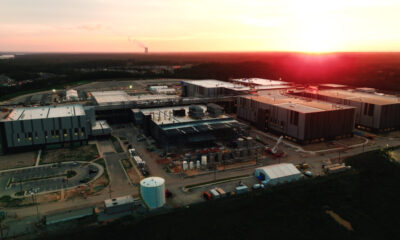Science
Blue Origin Advances Lunar Lander Development Amid Artemis 3 Shift

Blue Origin has made significant strides in its lunar exploration efforts, providing updates on its spacecraft development during a recent panel discussion. The company is preparing for its inaugural mission to the Moon, although it remains several years away from its contracted role in NASA’s Artemis 5 mission, slated for 2029. This comes as Artemis 3’s contract faces a reevaluation due to delays with SpaceX, which was initially awarded the contract for that mission.
During the American Astronautical Society’s 2025 von Braun Space Exploration Symposium, Jacqueline Cortese, Blue Origin’s Senior Director of Civil Space, outlined the company’s objectives for both crewed and uncrewed lunar missions. She emphasized the progress of the Blue Moon Mk. 1 lander, which is currently undergoing final assembly in Florida. The 8.1-meter-tall lander is designed to facilitate ongoing development for the larger Blue Moon Mk. 2, which stands at 15.3 meters.
Both lunar landers utilize BE-7 engines, which are undergoing extensive testing in various states, including Alabama, Texas, and Washington. Dave Limp, CEO of Blue Origin, shared a detailed video showcasing a hot fire test of the BE-7 engine, crucial for the lander’s Apogee Raise Maneuver.
Cortese highlighted that the assembly of the Mk. 1 involves three main modules currently being stacked at Blue Origin’s production facility in Port Canaveral, Florida. Once assembled, the lander will be transported to NASA’s Johnson Space Center for thermal vacuum testing, a critical phase before its mission.
The Mk. 1 is expected to launch with a payload that includes NASA’s SCALPSS (Stereo Cameras for Lunar-Plume Surface Studies) and LRA (Laser Retroreflective Array). Cortese hinted that the launch could occur within the coming weeks, although she did not provide specific dates.
As the company prepares the Mk. 1 for its demonstration flight, it is also ramping up production for additional units. The second Mk. 1 lander is currently in structural testing, with plans for a production line aimed at facilitating future missions.
Blue Origin’s long-term vision includes creating a sustainable lunar presence. Cortese confirmed that the Mk. 2 lander will require an uncrewed landing demonstration before it can carry astronauts as part of the Human Landing System (HLS) program. This mission will involve new technologies, including a Lunar Transporter for in-space cryogenic propellant transfer.
The Lunar Transporter is being developed alongside the Mk. 2 lander at the company’s facility in Florida. Cortese noted that Blue Origin has made significant advancements in cryogenic capabilities, reaching temperatures as low as 20 Kelvin in test environments.
The recent restructuring of NASA’s Artemis program has brought the future of the Artemis 3 mission into question. NASA Acting Administrator Sean Duffy announced plans to reopen the contract for Artemis 3, which had been awarded to SpaceX. Duffy expressed that competition will be encouraged to ensure timely progress, stating, “We’re in a race against China,” emphasizing the urgency of returning humans to the Moon.
In response to the contract adjustments, Cortese acknowledged the competitive landscape but remained circumspect about Blue Origin’s strategies. She noted, “We have what we think are some good ideas about maybe a more incremental approach that could be taken advantage of” for accelerating lunar missions.
This evolution in the Artemis program reflects broader ambitions within the aerospace sector for sustained lunar exploration and the establishment of a long-term presence on the Moon. As Blue Origin continues to advance its lunar lander technology, its role in the Artemis framework remains crucial for the future of space exploration.
-

 Science1 week ago
Science1 week agoInventor Achieves Breakthrough with 2 Billion FPS Laser Video
-

 Top Stories2 weeks ago
Top Stories2 weeks agoCharlie Sheen’s New Romance: ‘Glowing’ with Younger Partner
-

 Entertainment2 weeks ago
Entertainment2 weeks agoDua Lipa Aces GCSE Spanish, Sparks Super Bowl Buzz with Fans
-

 Business2 weeks ago
Business2 weeks agoTyler Technologies Set to Reveal Q3 Earnings on October 22
-

 Entertainment2 weeks ago
Entertainment2 weeks agoMother Fights to Reunite with Children After Kidnapping in New Drama
-

 World2 weeks ago
World2 weeks agoR&B Icon D’Angelo Dies at 51, Leaving Lasting Legacy
-

 Entertainment2 weeks ago
Entertainment2 weeks agoRed Sox’s Bregman to Become Free Agent; Tigers Commit to Skubal
-

 Science2 weeks ago
Science2 weeks agoNorth Carolina’s Biotech Boom: Billions Invested in Manufacturing
-

 Health2 weeks ago
Health2 weeks agoCurium Group, PeptiDream, and PDRadiopharma Launch Key Cancer Trial
-

 Health2 weeks ago
Health2 weeks agoCommunity Unites for 7th Annual Into the Light Walk for Mental Health
-

 Top Stories2 weeks ago
Top Stories2 weeks agoDisney+ Launches Chilling Classic ‘Something Wicked’ Just in Time for October
-

 Health2 weeks ago
Health2 weeks agoNorth Carolina’s Biotech Boom: Billions in New Investments









